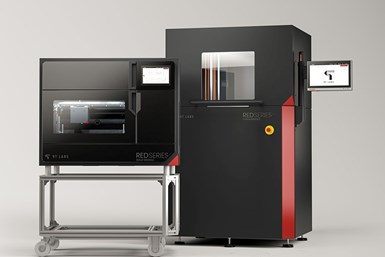9T Labs to Open First US Office in Boston
Company combines state-of-the-art additive manufacturing equipment with advanced postprocessing technology to enable serial manufacturing of structural composite parts.
Share
Read Next
9T Labs is set to open its first U.S. office in Boston, after being officially incorporated in the U.S. last month. The company specializes in digital, automated, cost-competitive series production of continuous fiber components.
The decision follows the company’s plans for expansion as it works to further commercialize its 9T Labs Red Series Additive Fusion Solution platform for the production of advanced continuous fiber-reinforced thermoplastic (CFRTP) composite parts.
9T Lab’s first office in the U.S. will give the country’s innovators in structural composites the opportunity to learn about and experience the Swiss company’s advancements in composite additive manufacturing (AM). The first U.S. team members will be signed in the coming weeks, with those employees travelling to Zurich, Switzerland, to train with the technology at 9T Labs’ headquarters.
“We are very excited to start this next step for the company,” says Martin Eichenhofer, 9T Labs CEO. “Our team is confident of a strong impact on the American markets by our latest innovations in advanced composite additive manufacturing, and we look forward to working with U.S. investors and expanding our reach to customers.”
John Hartner is the former CEO of ExOne in Pittsburgh, Pennsylvania, now serving as 9T Labs chairman based in the U.S. He is an experienced leader with more than 30 years’ involvement in the automation, semiconductor, clean tech and 3D printing industries. “I have been impressed by the company’s unique solution and am very excited to help the team to bring this technology to manufacturing companies around the world,” Hartner says.
9T Labs was founded in 2018 by a team of pioneers, focused on bringing the next generation of high-performance manufacturing. The company aspires to mass produce sustainable, high-performance composites as easily as metals. This is done by automating and digitizing the production workflow of composite production.
Related Content
-
Better, More Compact Radio Frequency Devices Through 3D Printing
3D printing technology company Fortify is applying its photopolymer process and material developed with Rogers Corporation to serve the expanding RF market.
-
Eaton Developing Carbon-Reinforced PEKK to Replace Aluminum in Aircraft Air Ducts
3D printable material will meet ESD, flammability and other requirements to allow for flexible manufacturing of ducts, without tooling needed today.
-
Aircraft Ducts 3D Printed in Composite Instead of Metal: The Cool Parts Show #68
Eaton’s new reinforced PEKK, tailored to aircraft applications, provides a cheaper and faster way to make ducts compared to formed aluminum.
















